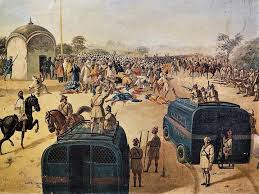GHULLA SINGH, BHAI (d. 1924), one of the martyrs of Jaito, was born around 1896, the son of Bhai Narain Singh and Mat Kishan Kaur, a Jatt Sikh couple of the village of Bhalur, near Bagha Purana, in present day Faridkot district of the Punjab. Tall and heavily built, Ghulla Singh helped his father and two elder brothers at tilling the family acre. He had received no formal education and was not yet married when the Akali agitation at Jaito protesting the forced abdication of the Sikh ruler of Nabha was gathering momentum. Ghulla Singh received the vows of the Khalsa at the hands of Sant Sundar Singh Bhindrarivale and became an Akali activist.
jaito
Explore the deeper meaning of Aarti in Hinduism and Sikhism, where true worship goes beyond rituals and embraces the beauty of nature and truth.
Explore the profound concept of Aatma and its connection to Paramaatma, God, and the transcendental self in Sikh and Hindu philosophies.
Explore the distinctive and largely unknown Sikh architectural style, with its rich history in gurdwaras, forts, and palaces, by S.S. Bhatti.
Discover the captivating history and architecture of Samman Burj, the octagonal Mughal marvel in Lahore Fort, known for its royal and administrative legacy.
Explore the profound concept of Aatma and its connection to Paramaatma, God, and the transcendental self in Sikh and Hindu philosophies.
Explore the deeper meaning of Aarti in Hinduism and Sikhism, where true worship goes beyond rituals and embraces the beauty of nature and truth.
Explore the profound concept of Aatma and its connection to Paramaatma, God, and the transcendental self in Sikh and Hindu philosophies.
Explore the deeper meaning of Aarti in Hinduism and Sikhism, where true worship goes beyond rituals and embraces the beauty of nature and truth.




